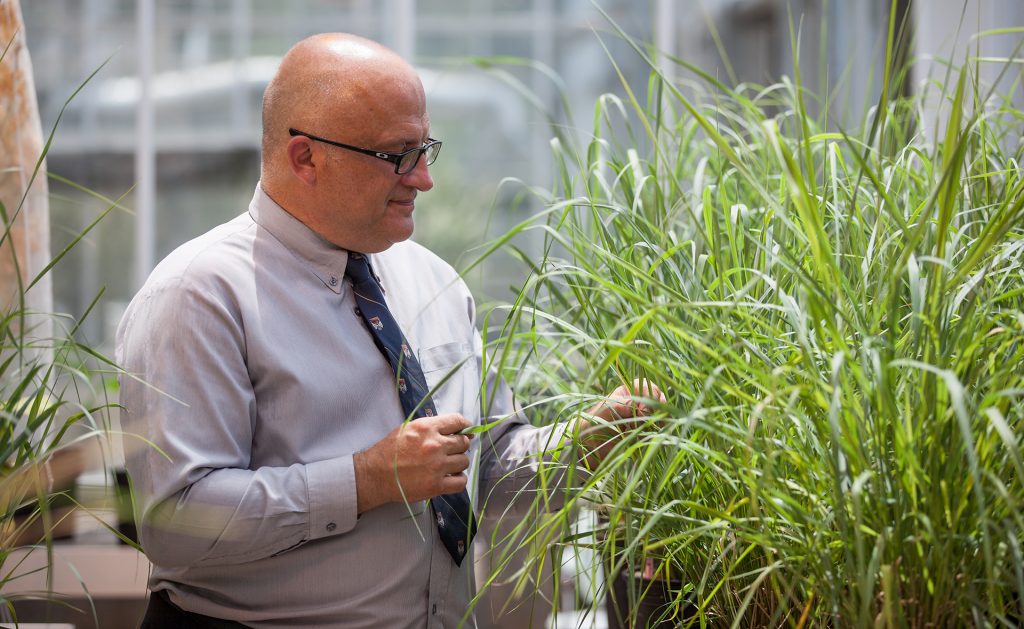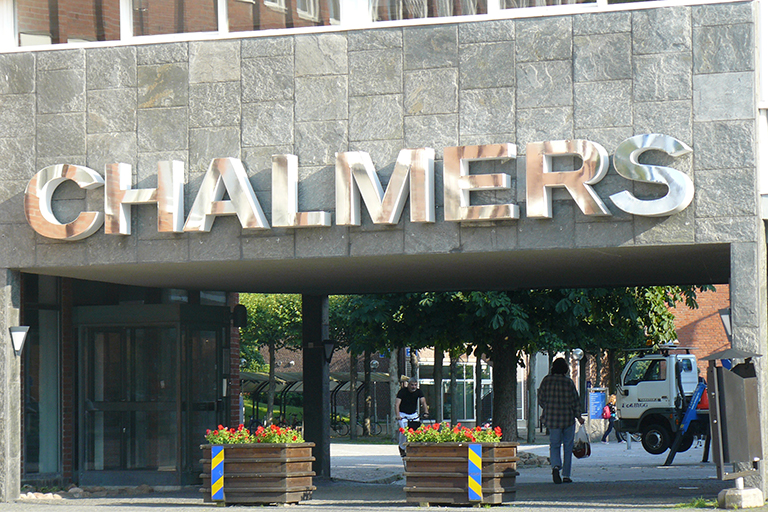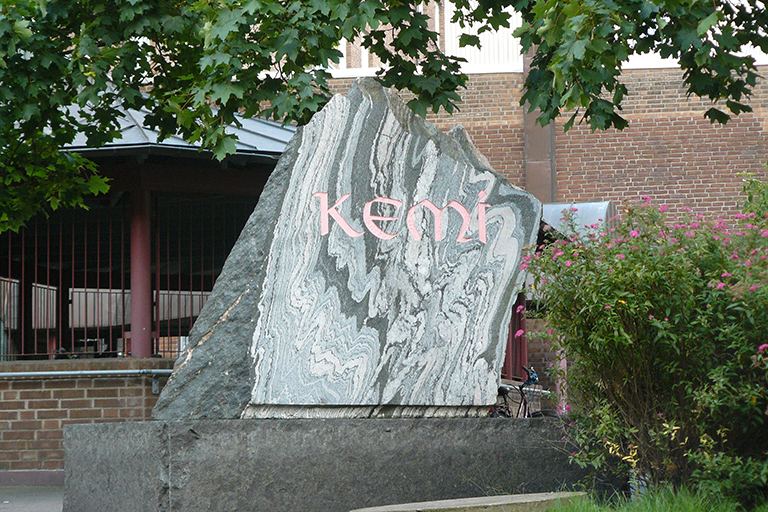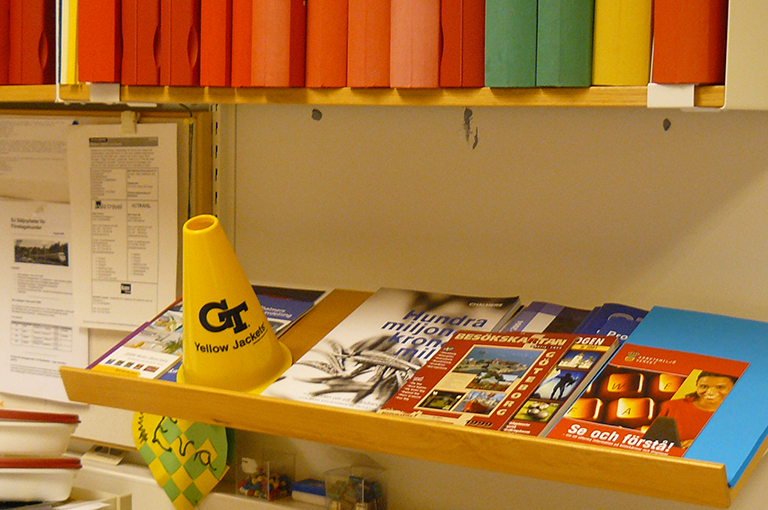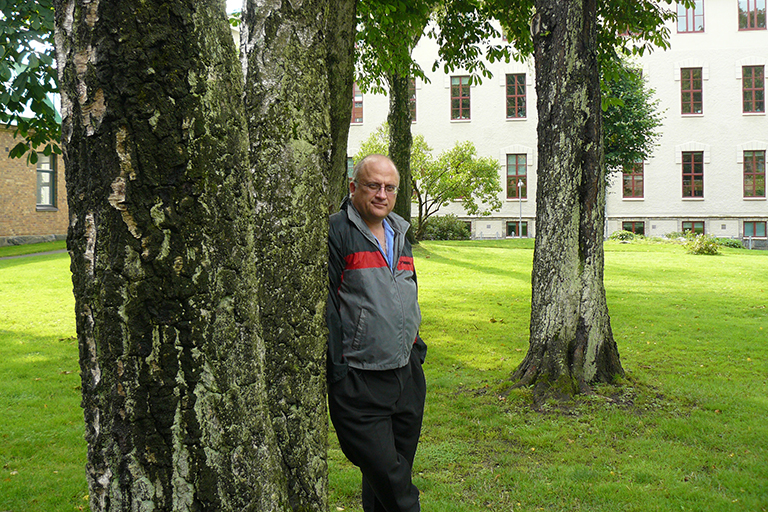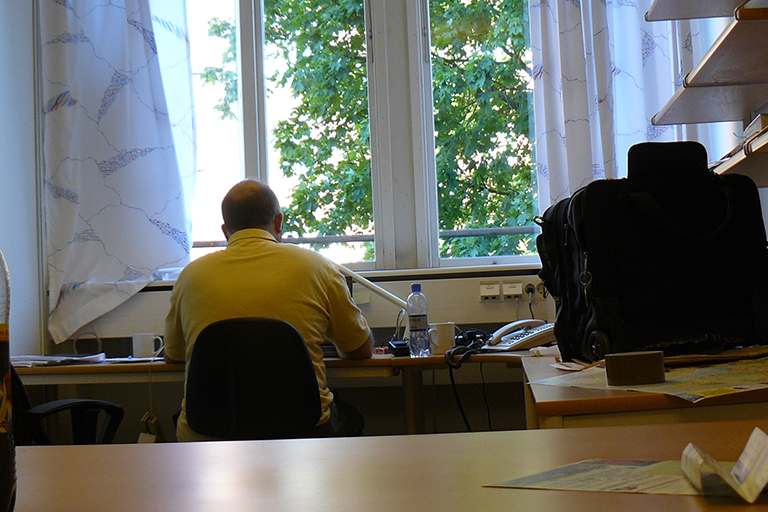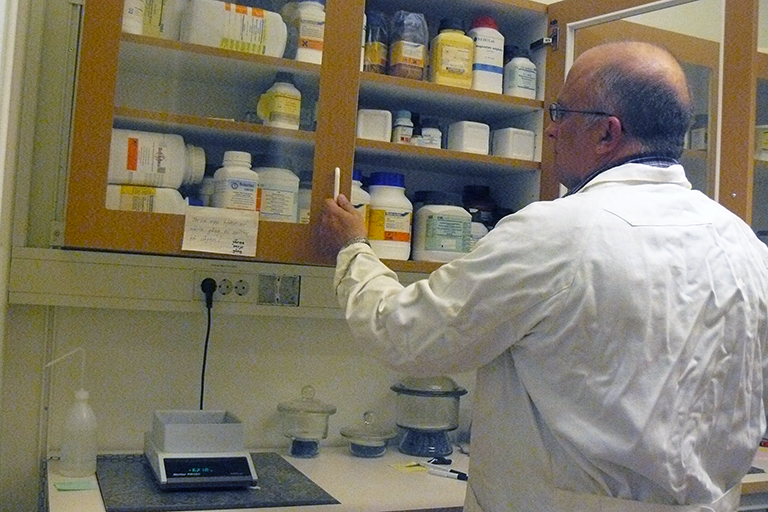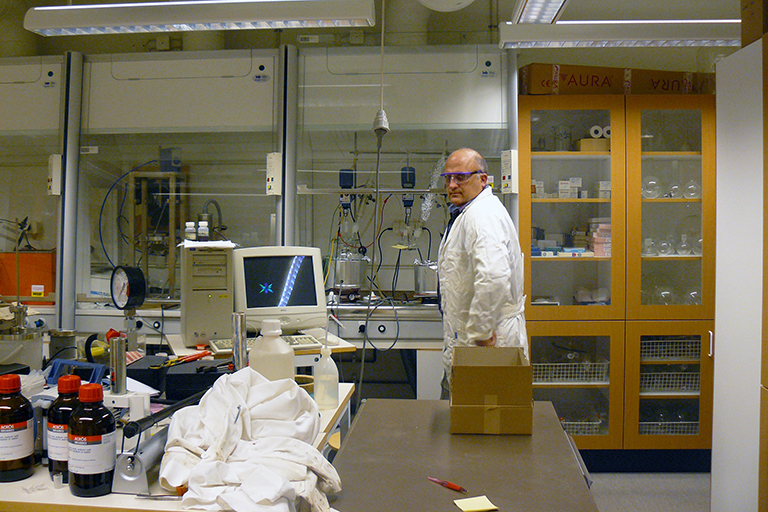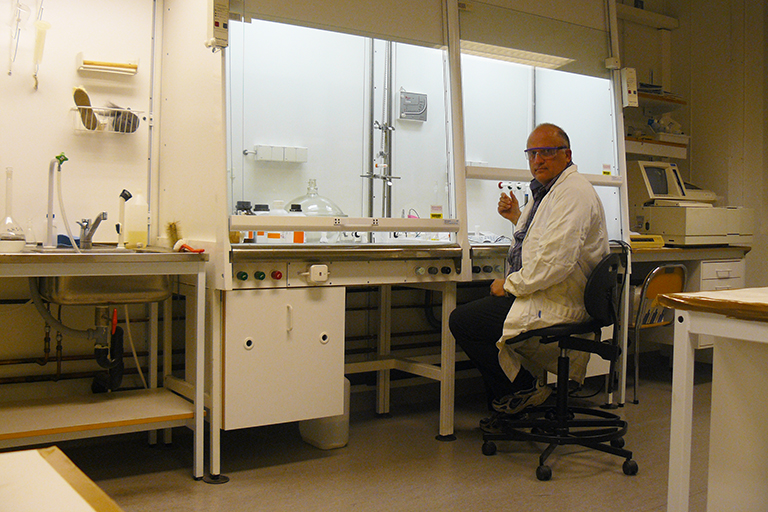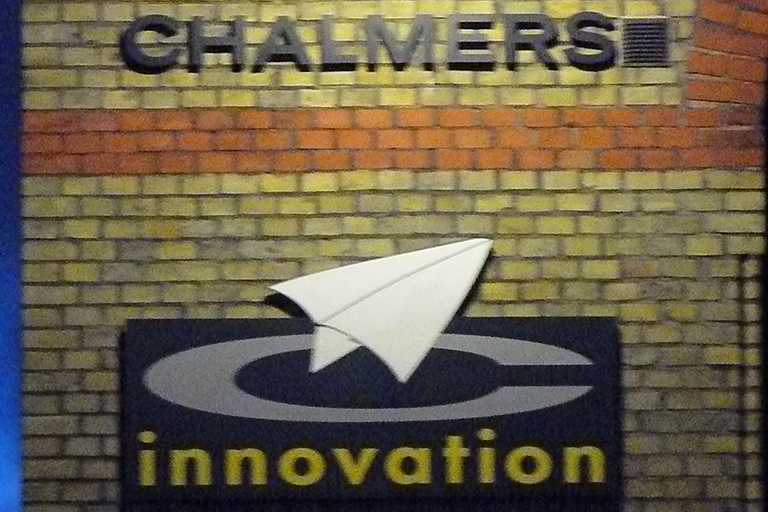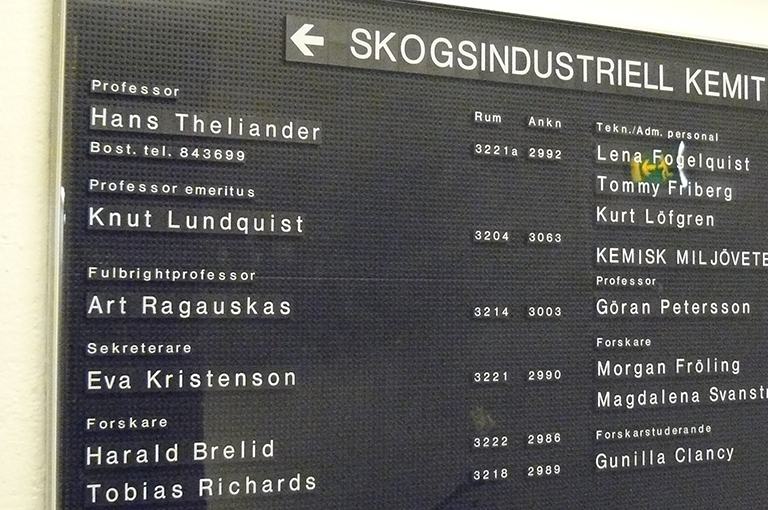Arthur Ragauskas held the first Fulbright Chair in Alternative Energy and is a Fellow of American Association for the Advancement of Science Fellow, the International Academy of Wood Science and TAPPI. His research program at Georgia Institute of Technology sought to understand and exploit innovative sustainable bioresources. This multifaceted program was targeted to develop new and improved applications for nature’s premiere renewable biopolymers for biomaterials, biofuels, biopower, and bio-based chemicals. He continues that research at the University of Tennessee as the UT-ORNL Governor’s Chair for Biorefining in the Department of Chemical and Biomolecular Engineering
His research program has been sponsored by NSF, USDA, DOE, GA Traditional Industry Program, a consortium of industry partners, and several fellowship programs. His Fulbright sponsored activities at Chalmers University of Technology, Sweden were focused on the forest biorefinery and new biofuel conversion technologies for lignocellulosics.
Ragauskas managed a research group of more than twenty-seven graduate students, postdoctoral research fellows, a research scientist, and visiting scientists. He has collaborative research projects with several GA Tech faculty and was the GA Tech team leader for Biological Energy Science Center (BESC) research efforts and team leader for an industrial consortium program titled Black Liquor Hemicellulose Recovery and Utilization.
His students have won several awards, including the ACS graduate research award Ragauskas is an Associate Editor for Biofuels, Bioproducts, and Biorefining; Biofuels; BioEnergy Research; Industrial Biotechnology; Taiwan Journal of Forest Service; TAPPI J.; Industrial Biotechnology; Holzforschung; Journal of Biobased Materials and Bioenergy; Journal of Petroleum Technology and Alternative Fuels; The Open Biotechnology Journal; Current Biotechnology; and J. Wood Chemistry and Technology.
He is an editorial board member of Sustainability and Journal of Chemical Technology and Biotechnology.
Ragauskas has served on several advisory boards and review panels including: Austrian Science Fund, European Commission Research Directorate, National Science Academy, J. Paul Getty Trust, NSF, USDA, DOE, ARAP-E, NSERC, BARD, FIRST, TAPPI Research Management Committee, Netherlands Organization for Scientific Research (NWO), Swedish Foundation for Strategic Research, Swedish VINN Excellence Center, Swedish Knowledge Foundation, VTT Technical Research Centre of Finland, ERA Chemistry, Swiss National Science Foundation, Finnish Academy of Science Norway Research Council, The Technology Foundation STW, Agence Nationale de la Recherche and Singapore Agency for Science, Technology and Research.
Ragauskas has been an invited visiting professor at Universidade da Beira Interior, Portugal; Chalmers University of Technology, Sweden; Royal Institute of Technology/ STFi, Stockholm, Sweden; and South China University of Technology, China.
More about Art Ragauskas
Arthur Ragauskas
UT-ORNL Governor’s Chair for Biorefining
Department of Chemical and Biomolecular Engineering
1512 Middle Drive
419 Dougherty Engineering Building
Knoxville, TN 37996-2200
Phone: 865-974-2421
Fax: 865-974-7076
E-mail: aragausk@utk.edu; ragauskas@hotmail.com
Teaching Philosophy
As an academician, Arthur Ragauskas’ core belief is that a professor can only be as successful as the students he educates, mentors, and graduates. As such, Ragauskas’ academic mission has been, and remains, the cornerstone of his career objectives. These career objectives include:
- Develop a challenging and enriching undergraduate educational and research experience that facilitates intellectual development of the students and supports the mission of the Department of Chemical and Biomolecular Engineering.
- Recruit, educate, and develop the next generation of scientists that will be nationally/internationally recognized leaders in green chemistry of biomaterials, biochemicals, biopower, biofuels and biological systems.
- Develop a nationally/internationally recognized research center for sustainable green chemistry of biopolymers and their conversion to innovative biomaterials, biochemicals, biopower, biofuels and biological systems.
Teaching Accomplishments
Ragauskas taught and developed several courses while at the School of Chemistry and Biochemistry at GA Tech, including Organic Chemistry, Chemistry of Pulping and Bleaching, and Biorenewable Polymers. Chemistry of Pulping and Bleaching and Biorenewable Polymers were new courses developed by Ragauskas. His average student teaching effectiveness for each course is as follows:
- Organic Chemistry, 4.4/5
- Chemistry of Pulping and Bleaching, 4.4/5
- Biorenewable Polymers, 5.0/5
In all three of these courses, Ragauskas strived to develop a teaching format that is tailored to the students’ needs and is directed at engaging the students so that they achieve intellectual excellence and growth. This goal has been pursued by developing a set of integrated multimedia teaching aids for classroom presentations and web-teaching aids; these are supplemented with a one-on-one teaching format for those students requiring additional mentoring and assistance. This past year Ragauskas was nominated by Chemistry 2312 students for the 2006 National Society of Collegiate Scholars Faculty of the Year Award.
With the integration of the Institute of Paper Science and Technology (IPST) into GA Tech, Ragauskas served on the academic integration committee and help structure the graduate Paper Science and Engineering program that is offered in several schools at GIT, including the School of Chemistry and Biochemistry. The course curriculum for this program required the development of two new graduate courses titled “Chemistry of Pulping and Bleaching” and “Biorenewable Polymers.” During the first two years at GIT, Ragauskas developed these courses, which are now offered on an annually basis. These courses have been well received by graduate students in chemistry and incorporate modern concepts of sustainability and green chemistry. These educational concepts have been acknowledged as a national need, as highlighted in the recent NSF-sponsored Chemistry Workshop on Sustainability (2006). Furthermore, these courses compliment GT’s School for Chemistry and Biochemistry interdisciplinary program titled Environmental Chemistry and Sustainable Technologies: Energy, Biorenewable Resources and “Green” Chemistry. In addition, Ragauskas was invited to present sections of the Chemistry of Pulping and Bleaching course to graduate students at the Departamenta Cienca Universidade da Beira Interior (Portugal) as a Luso-American Foundation Teaching Fellow (2003). In recognition of these accomplishments and prior teaching accomplishments, Ragauskas was elected a TAPPI Fellow in 2003.
Teaching Experience
›
Chalmers University
Fiber Line Bleaching (Graduate Level)
Department of Forest Products and Chemical Engineering
Chalmers University of Technology, Göteborg, Sweden (Letter of Reference)
Course Summary:
The course is directed at reviewing recent developments in advanced pulp bleaching. Students are introduced to advanced concepts in lignin/carbohydrate structure and pulp bleachability. State of the art pulp bleaching equipment, chemistry and environmental issues are explored.
Course Objectives:
- To provide a review of how lignin/carbohydrate structure influences pulp bleachability.
- Establish the relationship between basic pulp bleaching chemistry and modern bleach plant operations.
Course Outline:
- Structure of residual lignin in pulp after kraft pulping.
- Chemistry of lignin-removing and lignin-retaining bleaching.
- Difficulties in characterizing pulp (e.g., viscosity, kappa-number, optical properties, etc.).
- Kinetics of delignification.
- Process descriptions (layouts).
- Equipment used in bleaching plants.
- Environmental aspects of pulp bleaching.
- New bleaching technologies (e.g., enzymes).
›
Georgia Institute of Technology
CHEM 86996 Biorenewable Polymers
The course is directed at reviewing advanced chemical principles of biorenewable polymers including polysaccharides and lignin with a special emphasis on chemical derivatization, reactivity, and conformational analysis. Students are introduced to current concepts in conformational analysis of carbohydrates, chemical derivatization of carbohydrates and lignin, and the conversion of these biopolymers into biocomposites and biofuels.
CHEM 4341 Applied Spectroscopy
Applied spectroscopy theory and application of NMR, mass spectrometry, and infrared spectroscopy in the determination of organic structures. Students are introduced into the basic concepts of structural determination with a special emphasis on examples from the literature.
CHEM 2312 Organic/Bioorganic Chem
Organic and Bioorganic Chemistry second course in organic chemistry that extends the study to topics in biochemistry. Subject mater covered includes: Alcohols from Carbonyl Compounds; Conjugated Unsaturated Systems; Reactions of Aromatic Compounds; Aldehydes and Ketones and their chemistry; Carboxylic Acids and Their Derivatives; Synthesis and Reactions of ß-Dicarbonyl Compounds and Chemistry of Amines.
CHEM 8833A Pulping and Bleaching Chemistry
This course focuses on developing an understanding of the fundamental chemistry associated with pulping and bleaching of wood. The subject material encompasses: (1) the detailed analysis of the chemical structure of the major wood components, (2) the nature and scope of the reactions of pulping and bleaching reagents with typical carbohydrate and lignin functional groups, and (3) the underlying factors which explain differences in the degree of lignin vs. carbohydrate degradation during pulping and bleaching stages. The focus is on alkaline/NaSH pulping and ClO2, H2O2, O2/NaOH, O3 bleaching chemistry of chemical and mechanical pulps.
CHEM 86996 Biorenewable Polymers
The course is directed at reviewing advanced chemical principles of biorenewable polymers including polysaccharides and lignin with a special emphasis on conformational analysis, chemical derivatization, reactivity, and depolymerization. Students are introduced to current concepts of the biofinery, green chemistry/sustainability and the utilization of cellulose, hemicelluloses and lignin for biochemicals, biocomposites and biofuels.
›
Practical Continuing Education
Kraft Pulping/Bleaching Process Chemistry and Corrosion Prevention
By Arthur J. Ragauskas and Preet M. Singh
Modern kraft pulping and bleaching operations involve a host of chemical operations that frequently require high temperatures, pressures, and aggressive chemical agents. The key to improved mill operations and high-quality products is the successful utilization of these chemical operations to delignify/brighten kraft pulps while minimizing operating cost, equipment corrosion, and environmental impact.
This four-day course will review the practical chemical processes involved in modern kraft pulping and ECF bleaching operations that maximize bleaching performance while extending the life span of pulp/bleaching capital equipment. Upon completion of the four-day course students will have an improved understanding of kraft pulping and bleaching process chemistry and corrosion prevention.
›
Institute of Paper Science and Technology
A-20 Fundamentals of Organic Chemistry
The overall goal of this course is to provide the student with the fundamentals of organic chemistry with a focus on theoretical principles and general concepts. Topics that are of particular importance in the study of wood chemistry will be emphasized including acid/base chemistry, nucleophilic substitution reactions, electrophilic aromatic substitution reactions, elimination and oxidative chemistry.
A-6121 Pulping and Bleaching Chemistry
The conversion of wood into either chemical or mechanical pulps is accomplished in a modern pulp mill via a series of inter-connected chemical reactions. In addition, many modern environmental regulations and pulp processing technologies are based upon these chemical principals. This course focuses on developing an understanding of the fundamental chemistry associated with pulping and bleaching of wood. The subject material encompasses: (1) the detailed analysis of the chemical structure of the major wood components, (2) the nature and scope of the reactions of pulping and bleaching reagents with typical carbohydrate and lignin functional groups, and (3) the underlying factors which explain differences in the degree of lignin vs. carbohydrate degradation during pulping and bleaching stages. The focus is on alkaline/NaSH pulping and ClO2, H2O2, O2/NaOH, O3 bleaching chemistry of chemical and mechanical pulps.
A-6223 Advanced Pulping and Bleaching Chemistry
The course will take an in-depth look at the chemistry associated with pulping and bleaching. Particular attention will paid to the detailed proofs of the chemistries associated with lignin and carbohydrate fragmentation mechanisms. A special emphasis is placed on the chemical nature of residual lignin in kraft pulps and the influence of residual lignin on pulp bleachability by:
- Chlorine dioxide and Oxygen
- Chemistry of alkaline extraction of D0-bleached pulps
- Formation and influence of hexenuronic acids on pulp bleachability
- Pulp chromophore chemistry and its contribution to brightness ceilings
- Biodelignification and biobleaching of kraft pulps
- Proof of SNi and SN1 carbohydrate chain cleavage mechanisms
Defining the Opportunities, Challenges, and Research Needs for NanoBiomaterials Derived from Lignocellulosics
Proposal Objective: This proposal is for conducting a path breaking NSF Workshop directed at visionary new structural and non-structural opportunities for using nanoscale lignocellulosic-derived biomaterials. The workshop will: 1) identify new and important opportunities for nanoscale lignocellulosics as structural and nonstructural materials; 2) examine how recent advances in nanoscience and engineering can be employed or adapted to lignocellulosics from wood; and 3) identify fundamental research and development challenges, knowledge gaps, and research needs. Lignocellulose in woody plants is one of nature’s most abundant materials and wood-based lignocellulose at the macroscale level is one of our most used and ubiquitous materials. However, to-date, the intrinsic self-assembling nanoscale structure of wood lignocellulose as well as the versatility of its three key biopolymers: cellulose, hemicellulose, and lignin have been largely overlooked in nanoscience and engineering. This proposed workshop will address this oversight and provide a research pathway by which these lignocellulosic biopolymers will become the cornerstone of innovative structural and nonstructural nanoscale biomaterials that will contribute to the next generation of nanobiocomposite materials based on nature’s preeminent renewable and sustainable resource.
Introduction: From a broad historical viewpoint, the advancement of society has been intimately tied to mankind’s advances in materials science.1,2 From an engineering perspective, a common continuum mechanics research paradigm has enabled mankind to improve and develop new levels of material end use physical performance properties while simultaneously utilizing less material.3,4 These accomplishments have propelled the design and engineering of materials to more precise and exacting standards from the millimeter to micron scale and more recently to nanometer dimensions.5 In contrast, much of chemistry historically focused on the pico to nanometer scale as the structure of atoms and molecules were investigated and defined.6 As these challenges were addressed, the ability to utilize molecules to synthesize artificial biosystems, logic systems, and other nanometer-devices has become a subject of intense interest.7-9 Hence, at the beginning of a new millennium we find chemistry and engineering at a common nano-scale crossroad. As this arena of physical science is explored and defined, it is clear that nanoscience and technology offers tremendous opportunities, challenges, and rewards.
As outlined in Drexler’s paper published in the Proceedings of the National Academy of Sciences 10 the prospects for advanced molecular manufacturing technology to radically alter science and engineering is now well appreciated.11 Recent reviews by Romig,12 Tsakalakos13 and others serve14 to summarize how quantum, electrostatic, and Van der Waals forces at the nanoscale can dominate the resulting physical properties of nanoscale structures and why these materials frequently differ from materials designed on the micron or larger scale. Of the many aspects of nanoscale science and engineering one can view it developing in four-distinct phases:15-18
- Passive nanoscale materials
- Active nanoscale materials
- Systems of nanoscale systems
- Molecular systems of nanoscale systems
Directed development of nanoscale materials and systems has been an active field of research for the past two decades yielding a host of new materials.19 Until recently, many of these accomplishments have relied on our ability to control the atomic structure of inorganic materials such as carbon nanotubes, nanoclays, quantum dots, and other nanoparticles.20 Notably absent within the list of nanoscale science and engineering successes, until recently, has been the integration of biological materials. This, in part, is undoubtedly due to biomass polymers being soft materials and, as recently described by Hamley, the challenges in design, synthesis, and processing these biomaterials are numerous and difficult.21
Nonetheless, recent developments in nanoscale science and engineering, surface analysis,22 genetics,23 and computational modeling have provided a number of tools to address this growing frontier in science.24 Although significant efforts have been initiated with proteins25 and genetic material,26 much less have been proposed or initiated with nature’s most dominant bio-resources, lignocellulose and its constituents–cellulose, hemicellulose, and lignin. And yet, as a natural resource this source of biomass provides tremendous opportunities and benefits for our nation.27 The US has one of the most abundant and productive forest biomass capabilities in the world, which contributes to the nation’s economic, social, and environmental well being.28 These forests have enormous untapped potential to address major societal major issues including national energy security, global climate change, declining air and water quality, control of wild fires, rural development, and global competitiveness of our industries.29
Many of these societal benefits were recognized by David Morris, who coined the term “carbohydrate economy” 14 years ago.30 It was envisaged that by shifting society’s engine toward renewable, environmentally benign materials, agro/forestry-based manufacturing enterprises would have several positive ramifications including:
- Pollution and green house gases are no longer generated from extracting and processing crude oil into chemicals and fuels.
- End-of-life disposal is also not an issue-the products are completely biodegradable.
- Manufacturers are no longer saddled with high hazardous waste disposal costs, lengthy permit processes and compliance costs.
These benefits were clearly acknowledged in the Presidential Executive Order 13134, titled ” Developing and Promoting Biobased Products and Bioenergy.” Biofuel/ biochemical R&D investments are now clearly beginning to impact the national economy.31 For example, Congress recently passed legislation requiring refineries to raise their usage of biobased ethanol in gasoline from 1.8 billion gallons/annually (Note: 96% derived from corn) to 5.0 billion gallons annually within a decade.32 The successful introduction of corn-derived polylactic acid (PLA) into the market place (120 x 10 6 kgr annually) by Dow-Cargill Inc. is another example of the potential of the carbohydrate economy. Both of these products and others utilize plant carbohydrates for biofuel/ biochemical production. Nonetheless, these efforts will displace less than 5% of the hydrocarbons imported into the nation. Of the 14 quadrillion BTUs of biomass currently available, the U.S. uses less than 25% of this resource. However, our potential biomass resource – including fast-growing perennial herbaceous and woody plants – is estimated at 55 quads, of which 17 to 20 quads could reasonably be exploited by the year 2030.33 As documented by Cook and Beyea34 and McLaughlin and Walsh35 the use of these plant systems provides distinct reductions in the need for nonrenewable petroleum imports and valuable CO2 fixing benefits.36 America ‘s heavy reliance on imported petroleum jeopardizes our nation’s energy, economic, and environmental security. Approximately 20% of the imported hydrocarbons are used in the production of plastics and industrial chemical building blocks, and this provides an enormous opportunity to develop new biomaterials from this nation’s agricultural and forestry resources to replace petroleum-based materials. Nanotechnology research and development is critically important to produce the next generation of forest-based materials to meet the needs of a modern society while improving environmental conditions and contributing to the growth of the biomass-based economy.
The realization of this vision was recently acknowledged in the recent workshop titled “Nanotechnology Workshop for the Forest Products Industry.” A key component of this workshop and this proposal are the fundamental research challenges in nanoscale lignocellulosic biopolymer structures, novel surface phenomena, nanosystems integration, education, and introduction of nanobiomaterials derived from lignocellulsoics into the marketplace. This workshop37 identified three key opportunities to which nanoscale science and engineering could contribute:
- Lignocellulose and its constituent biopolymers are among the most abundant biological raw materials which are based on a nanofibrilar self assembling/self healing structure with a high degree of molecular fidelity. The fundamental understanding and control of these systems could provide innovative nanoscale systems for innovative multifunctional materials, electronic devices, bioagents, and composites;
- Nanoscale lignocellulosics and their interaction with other nanosystems could provide novel composite materials, new photovoltaics, water purification, artificial photosynthesis processes, biofuels and biomaterials;
- New analytical and modeling techniques are needed to identify and characterize the surface and superstructure of nanoscale lignocellulosic systems.
Major research opportunities include:
- Development of efficient separation technologies of nanofibrils of cellulose from wood and their incorporation into unique architecturally designed nanocomposites.
- Extraction and utilization of lignin, and hemicellulosics at the nanoscale for the development of innovative nanoscale particles, nanostructure devices, and systems.
- Develop understanding of the fundamental phenomenological properties at the nanoscale for lignocellosics and their interactions with other nanostructures.
- Controlled bioprocessing of nano lignocellusic materials with nanosystems yielding novel biomaterials.
- Development of the fundamental genetic and biological systems to tailor the biosynthesis of lignocellulosics and their respective ultrastructures.
This workshop involved approximately 130 researchers from industry, academia, and national laboratories primarily involved in forest products science and engineering fields. A key step in the development of this research vision into a national/international vision is the establishment of an interdisciplinary research program involving researchers from established forest products and nanotechnology research centers directed at synthesizing the next generation of nanobioterials derived from lignocellulosics. The next step in this process is the collaboration of research leaders in nanoscience and technology with researchers in wood science and technology to provide a detailed technical research/education roadmap. The proposed workshop will be instrumental in this aspect because it will bring together leading researchers in these areas and initiate discussion and collaboration between them.
Description of Proposed Workshop: This proposal builds off the previously held Nanotechnology Workshop for the Forest Products Industry workshop 37 and seeks to develop a focused two day workshop to identify the fundamental research challenges surrounding the opportunities of utilizing wood biopolymers to synthesize innovative nano biomaterials. This workshop will bring together leading national and internationally recognized researchers in nanotechnology and lignocellulosics and will provide important information and direction to the NSF on how nanotechnology science and engineering can:
- Design efficient lignocellulosic extraction and utilization technolologies for nanostructured materials
- Develop controlled assembly methodologies for nano lignocellulosics structures and their interactions with other nanosystems
Workshop Organizing Committee: The proposed organizing committee for the workshop involves:
- Associate Professor Arthur J. Ragauskas, School of Chemistry and Biochemistry, Institute of Paper Science and Technology, Georgia Institute of Technology, Atlanta, Georgia
- Assistant Professor W. Robert Ashurst, Department of Chemical Engineering, Auburn University, Alabama
- Professor Timothy G. Rials, Director of the Tennessee Forest Products Center, Department of Forestry, Wildlife and Fisheries, University of Tennessee Agricultural Campus
The organizing committee members represent a broad spectrum of research in nano, wood, and paper science and engineering. An additional strength of the proposed program committee is the breadth of expertise the senior participants bring in regards to hosting meetings, symposia, workshops, and conferences, as they have all organized and/or chaired professional conferences and workshops. Along with this expertise, the host institutions have a breadth of in-house capabilities upon which the senior participants can relay upon for development, coordination, and implementation of technical meeting.
Workshop Theme and Deliverables: The workshop will be held over two days and consist of technical presentations from all participants during the morning, afternoon and evening sessions. The goals of these sessions will be to provide a format for lively discussion and to produce a document that provides a consensus of opinion for the future of nano lignocellulosic materials research and education opportunities. In this regard, the organizers will invite, in addition to the thirty speakers, two provocative discussion leaders. The participants will be selected on the basis of the selection criteria outlined below:
- They represent a wide spectrum of nanoscience/engineering and wood science/engineering to insure that synergy occurs.
- The participants come from academia, industry, and government laboratories.
- The participants represent researchers at all stages in their careers from well established to new researchers just starting their career.
- An effort will be made to increase the representation of women and underrepresented minorities.
- Participants will be solicited from National User Facilities representatives to discuss and promote the variety of current and future analytical tools for nano characterization of materials. These include, but are not limited to, the new light sources and their facilities such as ORNL Center for Nanophase Materials and The Center for Nanoscale Materials at Argonne.
Workshop Application Process: Applicants will be requested to submit an electronic application including a one page Curriculum Vitae, a separate list of publications in the last 3 years, and a one page abstract identifying the new science that will be presented at the workshop. Candidates will be encouraged to present posters relevant to the workshop theme and representative of their research interest and capabilities. The organizing committee will limit the conference to 25 – 30 participants. The workshop conference itinerary, abstracts, presentations and outcome of the workshop groups will be hosted on this website.
Upon completion of this workshop, this public website will summarize the outcome of this meeting and will include the following materials:
- NanoBiomaterials Derived from Lignocellulosics Homepage
- NanoBiomaterials Derived from Lignocellulosics Participants
- Workshop Program
- Invited Presentations
- Position Papers
- Workshop Report
- Summary of Workshop Results and Conclusions
- Background Material
- Photographs from the Workshop
Co-sponsorship Opportunities: The American Forest and Paper Association (Washington DC), the national trade association of the forest products industry and coordinator of the industry’s Agenda 2020 Technology Alliance, has offered to contribute $5000 toward the workshop. The USDA Forest Service, Forest Products Laboratory (Madison, Wisconsin) has offered to contribute $5000 toward the workshop. (see Letters of Support)
Workshop Itinerary: This nation’s forest resources play an important role in the economic, social, and environmental performance of the U.S. and represent one of the top five global forest reserves. Recent changes in national and international competitiveness of the forest products industry have challenged the historical position of leadership this nation has held in this important industrial sector. These changes have resulted in a loss of current and future economic growth in many rural U.S. regions that are dependent on the forest products industry. And yet, within these challenging economic conditions, tremendous new opportunities are emerging. The recently hosted 2004 Forest Products Nanotechnology Workshop in Washington identified nanocomposites engineered from wood biopolymers as a unique material that could be readily utilized in several industrial sectors.
The objective of this workshop proposal is two-fold:
- Research: Develop a broad multidisciplinary workshop directed at evaluating the research needs, opportunities, and benefits of separating, synthesizing, and engineering nanostructures from wood biopolymers into advanced materials
- Education: Provide an opportunity by which national and international experts and other interested parties in can exchange ideas and concepts providing a unique cross-disciplinary learning opportunity.
It is anticipated that this NSF sponsored workshop will be a pivotal meeting that will lead to a new vision and roadmap that will highlight the future benefits and opportunities for the development of new nanobioterials based wood. The roadmap will leverage this nations’ position of leadership in nanotechnology with its preeminent renewable forest resources to develop a research roadmap that will contribute to the development of innovative value-added nanocomposites.
Working Group Organizational Considerations: The proposed program will bring together scientists with common materials interests from diverse backgrounds including nanoscale science and engineering; chemical engineering, material science, physical, biological, polymer, wood and organic chemistry, and analytical sciences as well as other science and engineering disciplines. The five proposed working groups will be staffed with a balance of researchers from established nanotechnology and forest products disciplines providing a synergistic cross disciplinary working environment. These working groups will provide a focus for the emerging field of nanolignocellulosic materials from both an educational and a research viewpoint. In addition, the working groups will promote a dialog and collaboration between industry, government, and academic scientists in an endeavor to identify and investigate fundamental and technological problems. The needs for this workshop were generally acknowledged at the recent NSF Grantees Conference on Nanoscale Science and Engineering (Dec., 2004) where Drs. P. Jones, T. Wegner, and A. Ragauskas presented a poster titled “Nanotechnology in the Forest Products Industry: Untapped Opportunities.”
I. Identify Key Opportunities/Applications of Nanotechnology in Assigned Topic AREA
Session Purpose : Identify unique synergies of nano and wood science. What are the primary opportunities and benefits to society? How could nanotechnology fundamentally change the “new” forest products industry (FPI) to manufacture nanostructured products, including novel biomaterials, functional smart nanobiostructures?
How can nanotechnology change the wood-based products that are produced?
How can it change manufacturing processes in the FPI?
What are the fundamental concepts for manufacturing forest products on the nanoscale? How can it enhance productivity, save energy, improve environmental performance, improve sustainability, and benefit national competitiveness and rural economies?
What are the engineering/manufacturing challenges?
What are the public benefits of government support for R&D in this area?
II. Goal Statement & Supporting Objectives for Technology Area
Session Purpose: Goal Statement:
Objective: Imagine that the goal has been successfully completed:
What will you need to have done to achieve this goal?
III. Identify BARRIERS
Session Purpose: Identify problems – that is, to identify the barriers/ challenges to achieving the goals.
IV . R&D and Related NEEDS
Session Purpose: Identify solutions and technical roadmap needed.
V. Linkages and Implementation: “Top-5 Analysis”
Session Purpose: Develop additional detail on the top-priority R&D needs to help justify and focus research/educational path forward.
Each working group will be staffed by a graduate student recorder that will take notes and record minutes. The chair and co-chair will present group status reports during the workshop and provide a summary report no later than one month after the workshop. The organizing committee will utilize these reports and invited papers (i.e., originating from the presentations) to provide NSF with a technical report that will define the basic nanoscience/engineering research needs for utilization of lignocellulosic at the nanoscale.
Workshop Outcome: The final report will provide a multidisciplinary national/international vision of the challenges, opportunities, and benefits of separating and synthesizing novel cellulose, lignin, and hemicellulosic nanoscale materials. The introduction will highlight that the synthesis and application nanobioterials derived from wood is a new field of science and technology, combining and drawing on the disciplines of physical, wood, computational, nano science and engineering. Workshop participants will define the exciting scientific opportunities offered by nanoscience and engineering with nature’s preeminent renewable resource, wood.
The final report will contain the follow sections:
- Statement of Workshop Purpose
- Introduction
- Motivation and General Background
- Research Enablers
- Fundamental Research Challenges and Opportunities
- Research Recommendations
- Education Recommendations
- Conclusions
- Acknowledgments
- Supporting Information
This report will be presented to NSF within three of months of concluding the workshop and it will incorporate the results of the presentations and the work group sessions. This report will also form the basis of a review article to be submitted to the journal Cellulose and presented at upcoming professional conferences hosted by the American Chemical Society (ACS), the American Institute of Chemical Engineers ( AIChE), Gordon Conference and trade-related organizations such as the Technical Association of the Pulp and Paper Industry (TAPPI), the Forest Products Society (FPS), and Nano Science and Technology Institute.
Workshop Location: The proposed workshop will be located on the campus of Georgia Institute of Technology, which is centrally located and has excellent transportation infrastructure. The meetings will be held at the Institute of Paper Science and Technology building on campus (Note: this provides a cost savings with respect to meeting facilities ). These facilities represent state-of-the-art seminar and break-out session rooms. All rooms will be equipped with desktop computers for the break-out session scribes and ample poster-paper for note-taking. In addition, wireless internet facilities will be available, on request to participants of the conference. Meals will be catered by the university catering company which routinely provides meal-support for meetings of 10 to +500 people. The university is surrounded by several modern hotel accommodations of varying-price range.
Conclusion: The program described in this proposal will establish the fundamental research and educational needs for the conversion of wood derived biopolymers into unique nanomaterials. The final report will become the roadmap for the next revolution in the development innovative nanobiomaterials derived from nature’s preeminent natural resource and yielding sustainable, environmental friendly nanomaterials that exhibit exceptional performance properties while contributing to economic and societal development.
Broader Impact Statement: The objective of this proposal is two-fold: (1) develop a broad multidisciplinary workshop directed at evaluating the research needs, opportunities and benefits of separating and synthesizing nanostructures for biopolymers derived from wood, along with the engineering needs for the integration of these materials into innovative composite structures (2) to educate professionals and the general public on the opportunities and science of converting lignocellulosics into innovative nanobiomaterials. It is anticipated that nanobiomaterials derived from wood will have broad applications in the packaging, transportation, and health care industry, and will displace the need for nonrenewable, petroleum-based materials currently employed. The need to develop new materials from bio-based feedstocks has seen increasing national importance as acknowledged in Presidential Executive Order 13134, titled ” Developing and Promoting Bio-based Products and Bio-energy.” This order challenges the research community to develop new materials derived from renewable biomaterials. The research deliverables of this proposal will be of prime value to the U.S.A. forest products industry that ranks among the top ten U.S. manufacturing industries. Along with this significant contribution to the nation’s GDP, the forestry industry frequently provides employment in many rural one-industry towns that are critically dependent upon their natural wood resources. The proposed workshop will provide a national/international opportunity to bring together researcher leaders in nanoscience and engineering and forest products science and engineering to define this vision. The workshop participants will be selected to represent a broad spectrum of interested participants from government, academia, national laboratories, and industry. Participants representing researchers at all stages in their careers from well established to new researchers just starting their career will be invited. A special effort will be made to increase the representation of women and underrepresented minorities at the workshop.
The workshop program, presentations, and final summary document will be placed on the internet to serve as a practical educational tool. In addition, a final report will be issued that represents a national consensus on research and educational needs, challenges, and benefits of a fundamental program directed at separation and synthesis of nano materials for wood biopolymers.
References:
-
- Kranzberg, M.; Smith, C. S. Part I. Materials in history and society. Materials Science and Engineering (1979), 37(1), 1-39.
- Hoshino, Y. Materials technology and society in 20th century. Kinzoku (2001), 71(3), 210-229.
- Roco, M. C. Nanoscale science and engineering: Unifying and transforming tools. AIChE Journal (2004), 50(5), 890-897
- Yakobson, B.I.; Dumitrica, T. Nanomechanics: physics between engineering and chemistry. ICASE/LaRC Interdisciplinary Series in Science and Engineering (2003), 9(Trends in Nanoscale Mechanics), 3-33.
- Goheen, S. C.; Gaither, K. A.; Rayburn, A. R. Nature and nanotechnology. NATO Science Series, II: Mathematics, Physics and Chemistry (2003), 128(Nanostructures: Synthesis, Functional Properties and Applications), 117-137.
- Zamecki, S. The emergence of the atomic-molecular chemical theory of John Dalton (1793-1810). Kwartalnik Historii Nauki i Techniki (2000), 45(2), 7-48.
- Prasanna , S.A. ; McClenaghan , N.D. ; McCoy, C.P. Molecular logic systems. Molecular Switches (2001), 339-361.
- Dujardin, E.; Mann, S. Bio-inspired materials chemistry. Advanced Materials ( Weinheim , Germany ) (2002), 14(11), 775-788.
- Bertau, M. Novel developments in biocatalytic organic chemistry. Current Organic Chemistry (2002), 6(11), 987-1014.
- Drexler, K. E. Molecular engineering: An approach to the development of general capabilities for molecular manipulation. Proc. Natnl. Acad. Sci. U.S.A. (1978), 5275-5278.
- Roco, M. C. From vision to the implementation of the U.S. National Nanotechnology Initiative. Journal of Nanoparticle Research (2001), 3(1), 5-11.
- Romig, A. D., Jr. Nanotechnology: Scientific challenges and societal benefits and risks. Metallurgical and Materials Transactions B: Process Metallurgy and Materials Processing Science (2004), B35(6), 1021-1028.
- Tsakalakos, T. Nanostructures and nanotechnology: Perspectives and new trends. NATO Science Series, II: Mathematics, Physics and Chemistry (2003), 128(Nanostructures: Synthesis, Functional Properties and Applications), 1-36
- Steinhart, M. Introduction to Nanotechnology by Charles P. Poole, Jr. and Frank J. Owens. Angewandte Chemie, International Edition (2004), 43(17), 2196-2197
- Roco, M.C. U. S. National Nanotechnology initiative: planning for the next five years. Nano-Micro Interface (2004), 3-9.
- Lieber, C.M. Nanoscale science and technology: building a big future from small things. MRS Bulletin (2003), 28(7), 486-491.
- Drexler, K. E. Molecular manufacturing: Perspectives on the ultimate limits of fabrication. Philosophical Transactions of the Royal Society of London , Series A: Mathematical, Physical and Engineering Sciences (1995), 353(1703), 323-31
- Frankfort, L.; Zheng, X.; Sohlberg, K. Mechanical molecular nanodevices. Encyclopedia of Nanoscience and Nanotechnology (2004), 5 73-89.
- Romig, A. D., Jr. Nanotechnology: Scientific challenges and societal benefits and risks. Metallurgical and Materials Transactions B: Process Metallurgy and Materials Processing Science (2004), B35(6), 1021-1028.
- Smith, B.W.; Luzzi, D.E. Carbon nanotubes. Introduction to Nanoscale Science and Technology (2004), 137-182.
- Hamley, I. W. Nanotechnology with soft materials. Angewandte Chemie, International Edition (2003), 42(15), 1692-1712.
- Nano-Surface Chemistry. Ed. Rosoff, M. USA . (2002), Publisher: Dekker, New York , N. Y.
- Seeman , N.C. DNA nanotechnology. Materials Today, (2003), 6(1), 24-29
- Goldbeck-Wood, G. Molecular modeling as nanotechnology tool. Nachrichten aus der Chemie (2004), 52(10), 1107-1108
- Rajagopal, K.; Schneider, J.P. Self-assembling peptides and proteins for nanotechnological applications. Current Opinion in Structural Biology (2004), 14(4), 480-486.
- Simmel, F.C. Artificial molecular machines from DNA. Bioforum (2004), 27(9), 28-29.
- Bowyer, J. L. Wood science in a changing world – Where are we headed? Wood Science and Technology (2000), 34(3), 175-181
- Sampson, R.N. Forestry opportunities in the United States to mitigate the effects of global warming. Water, Air, and Soil Pollution (1992), 64(1-2), 157-80.
- Forestry Best Management Practices Research in the Eastern United States: The State of Science 2002. [In: Water, Air, Soil, Pollut.: Focus, 2004; 4(1)]. Eds.: Shepard, J.P.; Aust, W.M.; Dolloff , C.A. ; Ice, G.G.; Kolka, R., (2004), Kluwer Academic Publishers, Dordrecht , Neth.
- Morris, D.; Irshad A. Carbohydrate Economy: Making Chemicals and Industrial Materials from Plant Matter . Washington , DC . Institute for Local Self-Reliance, (1992), NW, Washington. Federal Register: April 26, 2000, 65(81), 24593-24606.
- U.S. Department of Energy, Annual Energy Outlook 2001. December 22, 2000.
- Cook, J.; Beyea, J. Bioenergy in the United States : progress and possibilities. Biomass Bioenergy, (2000), 18(6), 441-455.
- Mclaughlin, S. B.; Walsh, M. E. Evaluating environmental consequences of producing herbaceous crops for bioenergy. Biomass Bioenergy, (1998), 14(4), 317-324.
- Annual Energy Outlook 2000 . DOE/EIA-0383. Washington , D.C. : U.S. Department of Energy(2000).
